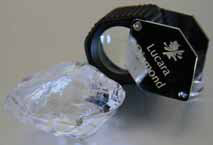
Open-pit mining during 2015 at Lucara’s Karowe property is expected to result in production of 350,000 to
400,000 carats, based on plant throughput of 2.2 million to 2.3 million mt. (Photo: Lucara Diamond Corp.)
Lucara Recovers Exceptional Diamonds at Karowe

Since recovery of the first large diamond at Karowe in 2013, Lucara has recovered 216 diamonds that have sold for more than $250,000 each. Twelve of these sold for more than $5 million each.
Lucara President and CEO William Lamb said, “The ongoing recovery of large, exceptional diamonds from the Karowe mine continues to support the resource estimates. The resource has consistently produced significant value for the company and its shareholders.
Karowe is a hard-rock, open-pit mine that has a planned depth of 324 m. Diamond production during 2015 is expected to be in the range of 350,000 to 400,000 carats based on plant throughput of 2.2 million to 2.3 million mt. Mine life is estimated at 13 years.

The Karowe mine is based on the AK6 kimberlite pipe, which is part of Orapa kimberlite field. The field includes at least 83 kimberlite bodies, varying in size from insignificant dykes to the 110-ha AK1 kimberlite that host’s Debswana mining company’s Orapa mine.
All of the kimberlite intrusions are of post-Karoo age. Of the 83 known kimberlite bodies, five including the AK6, are currently being mined, and a further four are recognized as having economic potential.